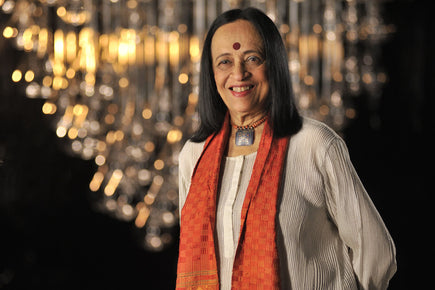The Progressive Artists' Group And Its Impact on Indian Modern Art
A collective of some of the most iconic artists of India, the Progressive Artists’ Group (PAG), formed in 1947 in Bombay, transformed the modern art scenario of the country. The founding members were rightly referred to as ‘heralds of a new dawn in the world of Indian art’ by celebrated author Mulk Raj Anand. They challenged the conservative artistic establishments of their times, and espoused a worldly mindset. The result was a beautiful synthesis of Indian art history with modernist styles such as post-impressionism, cubism and expressionism.
 (The Founding Members of PAG - front row: F.N. Souza, K.H. Ara and H.A. Gade, back row: M.F. Husain, S.K. Bakre and S.H. Raza)
(The Founding Members of PAG - front row: F.N. Souza, K.H. Ara and H.A. Gade, back row: M.F. Husain, S.K. Bakre and S.H. Raza)
The Impetus
The PAG (initially comprising F. N. Souza, S. H. Raza, M. F. Husain, K. H. Ara, H. A. Gade, and S. K. Bakre) came into being sometime after August 14, 1947 when the partition of India wreaked havoc on humanity, with many losing their lives or being dislocated. The partition is believed to have sowed the seed among the founding members to set new standards in the country, beginning with art.
Challenging the conservative art establishment of their times, the members desired to break away from the revivalist nationalism formed by the Bengal School of Art, and instead, promote a progressive style that was on par with international developments. The basic principle was to come out of the colonial hangover, and espouse a worldly mindset.
 (Hindu Princess by F.N. Souza, 1949)
(Hindu Princess by F.N. Souza, 1949)
How It All Began
Consumed by their desire to transform the art establishment of their times, Souza, Raza, Ara and critic Rashid Husain got together on December 5, 1947. They expressed their disillusionment with the state of the judging process at exhibitions. By setting up a judging committee, they wished to do away with the arbitrary selection process, and bring in greater transparency where emerging talents could get a fair platform to showcase their work.
 (An Exhibition of the Progressive Artists' Group)
(An Exhibition of the Progressive Artists' Group)
Raza, Souza, Ara and Bakre (convinced by Ara) had already made up their mind earlier to showcase their work together. Souza roped in Husain, and Raza initiated Gade into the world of PAG and thus, the group came into being. They initially choose to stick to six members to avert stylistic scramble.
 (Tonga by M.F. Husain, 1950)
(Tonga by M.F. Husain, 1950)
Later, however, PAG did expand, and revered artists such as Manishi Dey, Ram Kumar and Tyeb Mehta became associated with the group. By 1950, Krishen Khanna, Mohan Samant and V.S. Gaitonde joined the bandwagon as well. And while the venerated artist Akbar Padamsee was never an official member of the PAG, he established a lifelong bond with its members.
 (Betrayal by Krishen Khanna, 1950)
(Betrayal by Krishen Khanna, 1950)
Varied Styles
It is hard to club the vast body of work produced by the Progressive Artists’ Group under one category, as each artist was influenced by different movements and styles, and had a unique artistic approach and temper. The PAG members often merged Indian themes and imagery with western artistic techniques such as European modernism, post-impressionism, cubism and expressionism.
While K.H. Ara created striking watercolour and gouache paintings that resembled folk and native tribal art styles, F.N. Souza showcased an unconventional distortion of form and interestingly merged Goan folk art with western styles such as cubism. In contrast, H.A. Gade, is considered among the first abstract painters of post-independent India, who often painted themes related to landscapes.
 (Rock Lifes by H.A. Gade, 1949)
(Rock Lifes by H.A. Gade, 1949)
Perhaps the most recognized members of the PAG today, are S.H. Raza and M.F. Husain. A groundbreaking artist, Raza brought into his works the fluidity of Indian watercolour paintings. He mastered several forms, initially adopting an expressionistic style depicting lyrical landscapes, later moving towards an abstract style showcasing strong influences of geometric forms.
 (Untitled Landscape by S.H. Raza, 1948)
(Untitled Landscape by S.H. Raza, 1948)
M.F. Husain rendered a beautiful melange of folk art, tribal art and mythology, and was responsible for bringing to the country the most authentic flavor of cubism through his works, that often had resonances of symbolism as well.
The only sculptor cum painter in the group, Sadanand Bakre became renowned for introducing independent imagery in Indian art that differed from the traditional style of employing realism. His works were marked by their sensitive modelling, and distinct expression.
 (Untitled work by K.H. Ara, 1950)
(Untitled work by K.H. Ara, 1950)
The Decline of the PAG
By 1951, three of the key members of PAG moved abroad. Souza and Bakre departed for London, whereas Raza moved to Paris. Husain too began shuttling between Mumbai and Delhi. As a result, the group no longer functioned together, and the focus shifted to their individual work. After periodic exhibitions, the group dismembered sometime around 1956. The artists continued on their own accord, creating powerful works. One of the members, Gade even went on to create a group of his own, named Bombay Group of Artists, in the late 1950s.
Though short-lived, PAG had an immense bearing on the modern art scene of India. The ethos and works produced by members of the PAG, still reverberate in today’s art world.
























































































